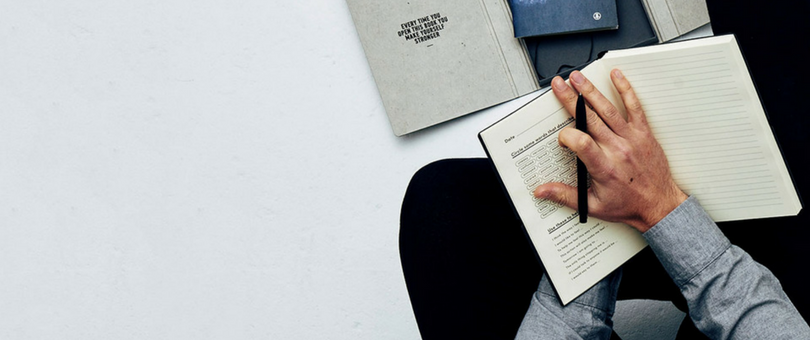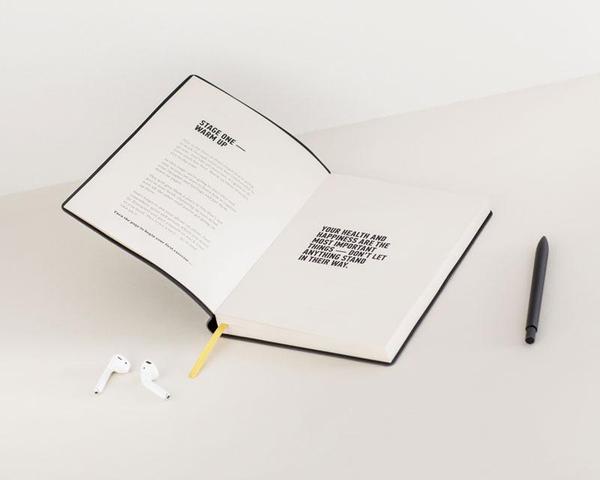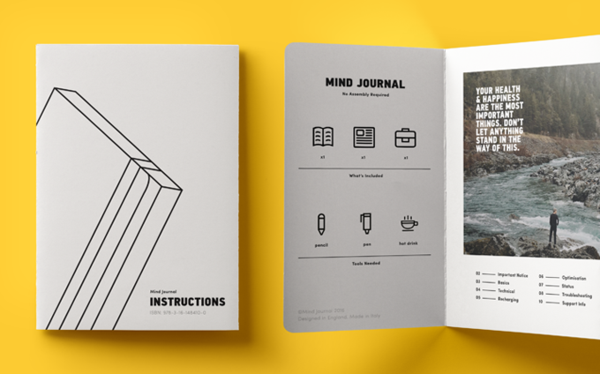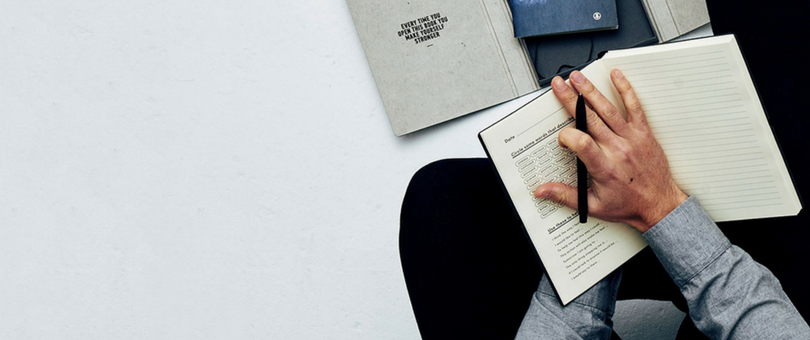 While the stigmas around mental health are finally being dismantled, the tools required to maintain a healthy mind are far less utilized than tools to stay physically fit — like a personal trainer or a trip to the gym.
While the stigmas around mental health are finally being dismantled, the tools required to maintain a healthy mind are far less utilized than tools to stay physically fit — like a personal trainer or a trip to the gym.
This is precisely why one designer decided to create a new kind of therapeutic tool. Mind Journal is a UK-based business which owner Ollie Aplin describes as a “personal trainer for the mind.” He created a journal with set prompts, including a daily check-in feature, to help his users lead happier and more productive lives.
Aplin got the idea in 2015 when a friend was going through a particularly rough patch in his life. A journal fanatic himself, Aplin suggested giving journaling a try to help him digest his feelings and process his emotions.
“He came back to me and said I gave it a go, but I didn’t know where to start,” said Aplin.
That was his lightbulb moment.
“I could totally connect with that feeling because I remember feeling that way pretty much every time I’d go to write. Usually, your head is just filled with the stuff from the day. Stuff that might have annoyed you, or stuff that you achieved that you are really pumped about.”
Aplin and his partner Natasha began toying with the idea of creating a guided journaling program. The guide would help people who had never journaled in their lives get more comfortable with free journaling. It took them another six months to solidify the concept of the product.
From there, Mind Journal launched on Kickstarter in February 2016 as the world’s first guided journal created just for men. With a funding goal of £17,500 (or around $23,200 USD), the product was funded in 72 hours and more than doubled its original goal for a total of £45,641 (more than $60,500 USD).
After its 25-day run on Kickstarter, Aplin opened his Shopify store to continue taking orders and sold out just a few months later. That’s when publisher Penguin Random House approached Aplin to create a more guided, research-based journal, called This Book Will Make You Stronger by MindJournal. This second iteration was distributed in retailers including Barnes and Noble.
Two years later, Aplin has produced a third version of the original Mind Journal, guided by the feedback from his community of journaling men.
“We both feel now that this third version is the sweet spot. We’ve got now almost two years of doing this and the audience has grown. I think we have got the absolute perfect framework now,” says Aplin.
Creating a Therapeutic Tool: Building a Business That’s Personal

Mind Journal is a personal endeavor that was never meant to be a money-making mission. Aplin lost his mother to suicide and understandably hit a low point in his life. He was prescribed journaling by his therapist in 2008 as a way to communicate his emotions and, like many men, he had difficulty speaking about what he was going through.
Communicating with a pen and a paper proved more palatable than sitting in a doctor’s office.
It was a complete game changer. Journaling completely opened me up to talk about stuff that happened, things I was feeling and things I was thinking.
Prior to journaling, Aplin suffered from issues with anxiety and panic attacks, but he never really knew why he was feeling the way he did. Daily journaling became a way for him to track those emotions and became his own sort of coach. Looking through a physical account of how he was feeling, Aplin could reflect and find a solution based on previously recorded experiences.
“When I first started getting into journaling, the main thing that it always came back to was my emotional state. What am I actually feeling and why am I feeling it? That was always the thing that kept coming back,” says Aplin.
Journaling is what helped Aplin come through a difficult time. After realizing that there was a need for this kind of therapeutic tool, his mission to help other guys was born.
“That’s the thing with Mind Journal — for us, we have never seen it as a money-making mission or a business, really,” he says.
“It was always just to create as designers and go, OK, here’s a problem that a mate had, here is a problem that I have, there are probably other guys that have it.”
Why don’t we make this thing and see if other guys find it useful? That was it. That was the only real objective. Can we help one guy?
Doing Your Homework: Mind Journal’s Research and Development
Aplin drew on his own personal experience when developing Mind Journal. He’s been in therapy for more than 10 years and has had many conversations with different therapists and psychotherapists on the topic of mental health.
Ahead of launching Kickstarter, he brought on one of those professionals, a psychology professor named Karen Pine, who acted as a sounding board throughout much of the research process.
“We would validate stuff through Karen. All the kinds of questions, the framework, and the program that we were creating, Karen had a big part of making sure that we were on the right path, that it made sense, and that it was all based on actual research and real evidence,” says Aplin.
Mind Journal was also user-tested. Aplin sent out handmade copies to 20 guys to capture their feedback prior to the Kickstarter launch, which was pushed a number of times. Aplin recommends collecting as much input as possible and budgeting enough time to produce a product that is as near perfection as it can be.
“Ask as many people as you can,” he recommends. “We would chat to people and they would say oh you haven’t gotten people to sign NDAs [non-disclosure agreements] and they could just steal your idea and launch it before you. I think people just worry too much about that stuff.”
“If you know what you are doing, and you trust what you are doing, and you are being original in yourself in that you aren’t copying anyone else’s idea, then you don’t have anything to worry about.”
People are always going to recognize originality, so just stick to that and don’t be so precious.
Thanks to its successful launch, Aplin had 1,500 Kickstarter backers he also called on for feedback via a survey. Questions focused on how users engaged with the product rather than worrying about the design. He asked questions such as what is or isn’t working for them, how long they used it for, and what they struggled with.
“Through each version we have created, we have constantly asked for feedback,” says Aplin. “We are the first ones doing this so it is constantly a case of testing and feedback and trying to make sure it is the best thing possible.”
Communicating With Your Target Audience

Mind Journal was never meant to be specifically for guys. Once the idea came to fruition and Aplin decided on its format, it then became a matter of audience. Keeping in mind that there were other journals on the market targeted at a wide audience, Aplin knew that he had to be more specific and again turned to his own experience for inspiration.
“Who do I feel comfortable talking to about this stuff? Strangely enough, I feel more comfortable talking to my dad and my mates who are guys about stuff that has happened or the way that I am feeling than I do with friends who are girls or the women in my family,” he says.
Once his audience was decided, Aplin began researching how men would react to a mindfulness product and how they would want to be guided. He quickly found that the research into men’s mental health was less than optimal.
“We looked at all the research that’s been going on around mental health and all the statistics. [We found] quite stark results around the impact of A) guys not looking after themselves, and B) guys not knowing how to look after themselves or having access to things to look after themselves better.”
Research also told him that he could not label Mind Journal as a mental health product. Men “switched off” from stereotypic health phrases such as “depression” and “anxiety.” Aplin’s research told him that men chose to not acknowledge these issues, refusing to admit that it could be something they’re experiencing.
“That’s where we have looked at phrases like ‘a personal trainer for your mind.’ It’s like a coach. It’s not self-help — it’s self-optimization. We have looked at all these kind of clever play on words to just make guys feel a little more comfortable around what we are doing.”
Building a Community (and a Product) Based on Feedback
Mind Journal was always meant for all men from those feeling vulnerable and struggling to top execs who use the tool to boost productivity. The Mind Journal community has members all around the world, with Penguin Random House translating the book version into German and Spanish.
The U.S. is the No. 1 country Mind Journal ships to, accounting for about 70% of all its orders, with residents middle states such as Texas being the most frequent purchasers.
While its reach is now broad, Aplin wasn’t afraid of having a smaller, but engaged community. And Aplin advises that other entrepreneurs should focus on building an engaged community as well.
“Don’t be afraid of just having 10 people in your little niche,” he says. “If you can sell to 10, you can sell to 100. If those 10 people are obsessed over you and can’t wait to share what you are doing with another 10 people, then that’s priceless,” says Aplin, who had a goal of starting with five people sign up for the initial Mind Journal holding page. “You can build on those 10 people much easier than a list of 300 people who you don’t know what they are about.”
Aplin suggests that entrepreneurs launch a landing page once they have their product developed so that they can begin getting feedback and building their community. This can be done using freelance graphic designers as a starting point before investing in branding. Questions to subscribers can range from their input into the color of the site, the logo, and style.
“It is quite easy as the creator to think you know best and while you probably do, it’s easy to become blindsided to that kind of thinking and forget that other people have to eventually buy [your product],” says Aplin.
“Having those people on board straightaway is so much more helpful. They almost become ambassadors for you because they were there straight away from day one and they go ‘oh, I remember when they asked my opinion on the logo.’ They are so much more vocal than the rest of your audience…”
From its first 20 testers pre-Kickstarter launch to its backers and American followers, Aplin knows its users’ needs by asking them for feedback and adjusting his product accordingly. To maintain engagement, Aplin sends out a newsletter every Monday with links to podcasts, articles, or a personal blog post he’s written. The newsletter is Mind Journal’s top engagement tool and is developed with specific customers’ preferences in mind.
“We don’t ever see them as our customers. We always say ‘Oh, the guys would like this’ and it’s like our mates, ‘Dave would really dig this link and he’d get a lot from that, so let’s put it in the newsletter.’ So, we always think of it in a very personal way, rather than clickbait,” he says.
Mind Journal’s Unique Approach to Marketing and PR
Aplin and his partner are also the co-founders of their own design studio called Well & Good. As designers with over 10 years of experience, their background gave them a head start when launching Mind Journal. Naturally, it easier for them to do things like prototyping, brand and website design, and choosing a good photographer or videographer.
“It massively helped because we could treat it like it was a client project and go this is how we would do it, this is the process that we know that leads to success for our clients. We can just replicate that for ourselves and create a really cool brand and design of the product ourselves,” says Aplin.
For the Kickstarter launch, a video was necessary. While it’s more expensive than photography, the medium fit the brand launch because Mind Journal needed a narrator — in this case, Aplin himself — to tell his story and the reason for creating the product.
He recommends that other entrepreneurs feature themselves in explainer videos or have another person in the video as a lead character.
“If you are brand new and you are doing something a little bit different that people might not get straight away, then do a video,” he says. “Put yourself in that video or put someone in that video so that there’s a character that people can connect to…it’s more memorable.”
If going the photo route, he suggests investing in professional photography to ensure that your site (or Kickstarter page) is top notch.
One professional service he feels entrepreneurs don’t need to hire is a PR professional. Six months prior to the Kickstarter launch, he began researching relevant press and collecting valid email addresses for the relevant person to cover his product. Then he connected with them on Linkedin, followed them on Twitter, and liked their social media posts to build a relationship.
“Be a normal human being. That, like any relationship, takes time,” he says. “Create those relationships with those press people yourself. It’s much better than creating those relationships for the PR firm. You almost become the third-party to the relationship. Be hands-on with it.”
From there, Aplin began drafting media pitches with a lighter, more humorous tone to them, sending them to friends to get their feedback. His approach was less of a hard sell, but he always ensured that the information was easy to read and a press kit was easily accessible. He used Dropbox to send the press information and included a press release, high-resolution images, and a link to the video.
“Provide them with as much information as possible. There’s nothing worse than when you get a great story and ask if you’ve got an image and they send you one but it is in low-res. Just sort all that stuff out so that it is easy for them,” he says.
He also suggests that other business owners give themselves more time than you expect to prepare and be patient when it comes to hearing back from press. His approach won him huge press wins in publications including the Telegraph, The Guardian, LadBible, and Huffington Post.
While press wins are great for exposure, Aplin still gets the most satisfaction from guys like him who have gone through a tough time and used journaling to come out the other side.
Helping that one guy, whoever he is, wherever he is, that has used the journal and is living a better, happier, more relaxed life. That’s the big achievement. That’s the win.

